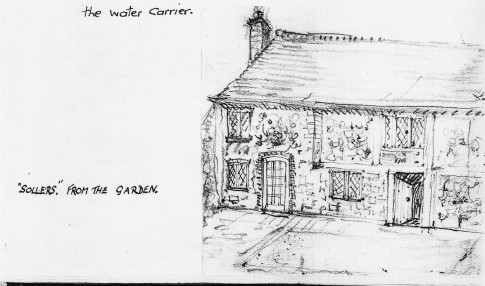The Fernhurst Society
Memories of Fernhurst: the village
previous page | next page | Contents
THE VILLAGE
Memory recalls life in Fernhurst, its countryside and people. We hope to recapture the enjoyment, outlook and activities, with a measure of continuity and to seek the general and not the particular view.
Fernhurst is said to mean ‘Fara’s Wood’ by some authorities, ‘Fernwood’ from other sources. About sixty years ago it was pronounced ‘Farnhurst’ by the residents, and said to mean’Bracken Wood’. Fernhurst lies in the anticline between Blackdown and Telegraph Hill, and is situated in the midst of some of the most beautiful scenery in Sussex, with much woodland, which helps to retain its charm. Many inhabitants are employed on the land, and in the woods the sound of the axe may still be heard as the woodmen cut the chestnut saplings, or trim the oaks, which look to have withstood the storms of centuries. Blue smoke rises from the woods and the tractor is heard on the land, with the seagulls following as they followed the horses of bygone days.
Fernhurst is on the main road from London to Chichester on the edge of West Sussex. A wonderful panorama unfolds, both on entering the village and further on through the village, especially as one nears the top of Henley Hill, there is a view of the Sussex Weald, which can rarely be equalled by main of England’s beauty spots.
Crossing the main road in the centre of the village, where once stood the cross, now a traffic sign, are roads to the church and to Lynchmere. Memory recalls that these east and west roads were once bridle paths to the commons. Standing on the crossroads, within glancing distance are the village store, the Post Office, the church, Lloyds and Westminster Banks, the Village Hall, the petrol stations, working Men’s Club, Co-operative Stores, Spread Eagle pub, boot and shoe repairing hut and houses that are good to see.
Fernhurst has a population of about 2,000, whose welfare is in the charge of the Parish council, which is very representative.
Industries are very varied, many are new, and we shall revisit many pleasant occupations remembered by the older inhabitants of Fernhurst. There are large and small farms, small builders, the Henley common Fencing, Research Station at Verdley, Burrows & Paine car service, oil heating service. The church and village school we shall visit with memories that have special places. There is a half-hourly bus service through the village linking Haslemere and Midhurst.
The kindly folk of Fernhurst reconstruct the village centre and tell of a butcher’s shop and a chemist’s shop where the banks now are. There was also a joiner’s on the site of Cole’s paper shop and the Co-operative Stores.
A village blacksmith was once across the road by the Post Office, where the horses patiently awaited for their turn.There are many new houses that have grown up to mingle with the older ones and two council estates on the outskirts of the village. All mingle to form a very pleasant village, with gardens well tendered, and still growing the sweet old-fashioned flowers mixed with more modern plants. Lavender and sweet briar, columbines and larkspur, Canterbury bells and tall hollyhocks, blended with sweet Williams and moss roses are a very charming picture. The old wells are to be seen kept as garden features and add greatly to memories of years gone by, when conversation and much chatter lightened the toil of the water carrier.
previous page | next page | Contents



The Fernhurst Oral History Project was supported by the Local Heritage Initiative. The Local Heritage Initiative was developed by the Countryside Agency and was funded by the Heritage Lottery Fund and Nationwide Building Society.


